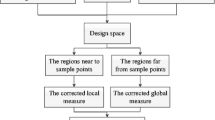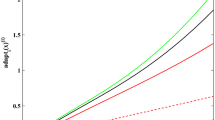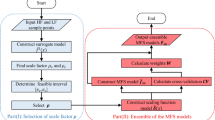Abstract
For computationally expensive black-box problems, surrogate models are widely employed to reduce the needed computation time and efforts during the search of the global optimum. However, the construction of an effective surrogate model over a large design space remains a challenge in many cases. In this work, a new global optimization method using an ensemble of surrogates and hierarchical design space reduction is proposed to deal with the optimization problems with computation-intensive, black-box objective functions. During the search, an ensemble of three representative surrogate techniques with optimized weight factors is used for selecting promising sample points, narrowing down space exploration and identifying the global optimum. The design space is classified into: Original Global Space (OGS), Promising Joint Space (PJS), Important Local Space (ILS), using the newly proposed hierarchical design space reduction (HSR). Tested using eighteen representative benchmark and two engineering design optimization problems, the newly proposed global optimization method shows improved capability in identifying promising search area and reducing design space, and superior search efficiency and robustness in identifying the global optimum.






Similar content being viewed by others
References
Acar E (2010) Various approaches for constructing an ensemble of metamodels using local measures. Struct Multidiscip Optim 42(6):879–896
Acar E, Rais-Rohani M (2009) Ensemble of metamodels with optimized weight factors. Struct Multidiscip Optim 37(3):279–294
Ahmed MYM, Qin N (2012) Surrogate-based multi-objective aerothermodynamic design optimization of hypersonic spiked bodies. AIAA J 50(4):797–810
Bates SJ, Sienz J, Langley DS (2003) Formulation of the Audze-Eglais Uniform Latin Hypercube design of experiments. Adv Eng Softw 34(8):493–506
Bezdek JC (1981) Pattern recognition with fuzzy objective function algorithms. Plenum Press, New York
Bishop CM (1995) Neural networks for pattern recognition. Oxford University Press, New York
Boudjehem D, Boudjehem B, Boukaache A (2011) Reducing dimension in global optimization.Int J Comput Methods 8(3):535–544
Clarke-Pringle T, MacGregor JF (2000) Reduced dimension control of dynamic systems. Ind Eng Chem Res 39(8):2970–2980
Coello CAC (2000) Use of a self-adaptive penalty approach for engineering optimization problems. Comput Ind 41(2):113–127
Dong HC, Song BW, Dong ZM et al (2016) Multi-start space reduction (MSSR) surrogate-based global optimization method. Struct Multidiscip Optim 54(4):907–926
Dougal RA, Gao L, Liu S (2004) Ultracapacitor model with automatic order selection and capacity scaling for dynamic system simulation. J Power Sources 126(1):250–257
Eves J, Toropov VV, Thompson HM et al (2012) Design optimization of supersonic jet pumps using high fidelity flow analysis. Struct Multidiscip Optim 45(5):739–745
Fan CB, Huang YB, Wang QF (2014) Sparsity-promoting polynomial response surface: A new surrogate model for response prediction. Adv Eng Softw 77:48–65
Fang H, Rais-Rohani M, Liu Z et al (2005) A comparative study of metamodeling methods for multiobjective crashworthiness optimization. Comput Struct 83(25):2121–2136
Goel T, Haftka RT, Shyy W et al (2007) Ensemble of surrogates. Struct Multidiscip Optim 33(3):199–216
Gu J, Li GY, Dong Z (2012) Hybrid and adaptive meta-model-based global optimization. Eng Optim 44(1):87–104
Gupta P, Mehlawat MK, Mittal G (2012) Asset portfolio optimization using support vector machines and real-coded genetic algorithm. J Glob Optim 53(2):297–315
Halbwachs N, Merchat D, Gonnord L (2006) Some ways to reduce the space dimension in polyhedra computations. Formal Methods Syst Des 29(1):79–95
Hosder S, Watson LT, Grossman B et al (2001) Polynomial response surface approximations for the multidisciplinary design optimization of a high speed civil transport. Optim Eng 2(4):431–452
Jin R, Chen W, Simpson TW (2001) Comparative studies of metamodelling techniques under multiple modelling criteria. Struct Multidiscip Optim 23(1):1–13
Jin R, Chen W, Sudjianto A (2005) An efficient algorithm for constructing optimal design of computer experiments. J Stat Plan Inference 134(1):268–287
Kim B, Lee YB, Choi DH (2009) Construction of the radial basis function based on a sequential sampling approach using cross-validation. J Mech Sci Technol 23(12):3357–3365
Koch PN, Simpson TW, Allen JK et al (1999) Statistical approximations for multidisciplinary design optimization: The problem of size. J Aircraft 36(1):275–286
Lee Y, Choi D-H (2014) Pointwise ensemble of meta-models using v nearest points cross-validation. Struct Multidiscip Optim 50(3):383–394
Liefvendahl M, Stocki R (2006) A study on algorithms for optimization of Latin hypercubes. J Stat Plan Inference 136(9):3231–3247
Lu L, Gao Y, Li Q et al (2017a) Numerical investigations of tip clearance flow characteristics of a pumpjet propulsor. Int J Naval Arch Ocean Eng. https://doi.org/10.1016/j.ijnaoe.2017.09.001
Lu L, Li Q, Gao Y (2017b) Numerical investigation of effect of different tip clearance size on the pumpjet propulsor performance. J Huazhong Univ Sci Technolog Med Sci 45(8):110–114
Mack Y, Goel T, Shyy W et al (2005) Multiple surrogates for the shape optimization of bluff body-facilitated mixing. In: 43rd AIAA aerospace sciences meeting and exhibit, Reno, NV, Jan 10-13. AIAA-2005-0333
McDonald DB, Grantham WJ, Tabor WL et al (2007) Global and local optimization using radial basis function response surface models. Appl Math Model 31(10):2095–2110
Melo VVD, Delbem ACB, Pinto JDL et al (2007) Improving global numerical optimization using a search-space reduction algorithm. In: 9th annual conference on genetic and evolutionary computation, ACM, New York pp. 1195-1202
Mullur AA, Messac A (2005) Extended radial basis functions: more flexible and effective metamodeling. AIAA J 43(6):1306–1315
Mullur AA, Messac A (2006) Metamodeling using extended radial basis functions: a comparative approach. Eng Comput 21(3):203–217
Ng HK, Sridhar B (2016) Computational approaches to simulation and optimization of global aircraft trajectories. J Aerospace Info Syst 13(2):1–13
Pan G, Ye PC, Wang P (2014a) A novel latin hypercube algorithm via translational propagation. Sci World J. 2014:163949. https://doi.org/10.1155/2014/163949
Pan G, Ye PC, Wang P et al. (2014b) A sequential optimization sampling method for metamodels with radial basis functions. Sci World J. 2014:192862. https://doi.org/10.1155/2014/192862
Rennen G, Husslage B, Van Dam ER et al (2010) Nested maximin Latin hypercube designs. Struct Multidiscip Optim 41(3):371–395
Rothuizen E, Merida W, Rokni M et al (2013) Optimization of hydrogen vehicle refueling via dynamic simulation. Int J Hydrog Energy 38(11):4221–4231
Sanchez E, Pintos S, Queipo NV (2008) Toward an optimal ensemble of kernel-based approximations with engineering applications. Struct Multidiscip Optim 36(3):247–261
Shan S, Wang GG (2010) Survey of modeling and optimization strategies to solve high-dimensional design problems with computationally-expensive black-box functions. Struct Multidiscip Optim 41(2):219–241
Shao WZ, Deng HS, Ma YZ et al (2012) Extended gaussian kriging for computer experiments in engineering design. Eng Comput 28(2):161–178
Shen KC, Pan G, Lu JF (2017) Buckling and layer failure of composite laminated cylinders subjected to hydrostatic pressure. Sci Eng Compos Mater 24(3):415–422
Simpson TW, Mistree F (2001) Kriging models for global approximation in simulation-based multidisciplinary design optimization. AIAA J 39(12):2233–2241
Tang YF, Chen JQ, Wei JH (2013) A surrogate-based particle swarm optimization algorithm for solving optimization problems with expensive black box functions. Eng Optim 45(5):557–576
Van DER, Husslage B, Den Hertog D et al (2007) Maximin Latin Hypercube Designs in Two Dimensions. Oper Res 55(1):158–169
Viana FAC, Haftka RT, Steffen V (2009) Multiple surrogates: how cross-validation errors can help us to obtain the best predictor. Struct Multidiscip Optim 39(4):439–457
Viana FAC, Haftka RT, Watson LT (2013) Efficient global optimization algorithm assisted by multiple surrogate techniques. J Glob Optim 56:669–689
Viana FAC, Venter G, Balabanov V (2010) An algorithm for fast optimal latin hypercube design of experiments. Int. J Numer Methods Eng 82(2):135–156
Wang GG (2003) Adaptive response surface method using inherited latin hypercube design points. J Mech Eng 125(2):210–220
Wang GG, Dong Z, Aitchison P (2001) Adaptive response surface method-a global optimization scheme for approximation-based design problems. Eng Optim 33(6):707–733
Wang GG, Shan S (2007) Review of metamodeling techniques in support of engineering design optimization. J Mech Des 129(4):370–380
Wang LQ, Shan SQ, Wang GG (2004) Mode-pursuing sampling method for global optimization on expensive black-box functions. Eng Optim 36(4):419–438
Wang GG, Simpson T (2004) Fuzzy clustering based hierarchical metamodeling for design space reduction and optimization. Engineering Optimization 36(3):313–335
Xie Y, Eldar YC, Goldsmith A (2013) Reduced-dimension multiuser eetection. IEEE Trans Inf Theory 59(6):3858–3874
Ye PC, Pan G (2015) A novel sequential approximate optimization approach using data mining for engineering design optimization. Optim Methods Softw 30(6):1255–1275
Ye PC, Pan G (2017a) Global optimization method using adaptive and parallel ensemble of surrogates for engineering design optimization. Optimization 66(7):1135–1155
Ye PC, Pan G (2017b) Global optimization method using ensemble of metamodels based on fuzzy clustering for design space reduction. Eng Comput 33(3):573–585
Younis A, Dong Z (2010) Metamodelling and search using space exploration and unimodal region elimination for design optimization. Eng Optim 42(6):517–533
Zhou XJ, Ma YZ, Li XF (2011) Ensemble of surrogates with recursive arithmetic average. Struct Multidiscip Optim 44(5):651–671
Zhu H, Liu L, Long T et al (2012a) A novel algorithm of maximin Latin hypercube design using successive local enumeration. Eng Optim 44(5):551–564
Zhu HG, Liu L, Long T et al (2012b) Global optimization method using SLE and adaptive RBF based on fuzzy clustering. Chinese J Mech Eng 25(4):768–775
Acknowledgements
Supports from National Natural Science Foundation of China (Grant No. 11502210, 51709229 and 51479170), National Key Research and Development Project of China (Grant No. 2016YFC0301300), Innovation Foundation for Doctor Dissertation of Northwestern Polytechnical University (Grant No. CX201603), and the Natural Sciences and Engineering Research Council of Canada are greatly acknowledged. The authors are also grateful to previous members of the research team for sharing their optimization algorithms and test examples.
Author information
Authors and Affiliations
Corresponding author
Appendices
Appendix 1: Description of selected surrogate modeling techniques
1.1 Polynomial response surface, PRS
Polynomial response surface, also called response surface method (RSM) is one of the most popular surrogate modeling techniques. It first generates a number of design points, then uses either a second-order model or a higher order model to replace the unknown system. The most commonly used PRS model is the second-order model in the form as:
where n is the number of variables in the input vector x, \( \tilde{y}\left(\boldsymbol{x}\right) \) is the response surface approximation of the actual function. β0, βi, βii, βij represent the unknown regression coefficients which can be computed by the least squares method.
1.2 Radial basis function, RBF
Radial basis function is originally developed by Hardy in 1971 to fit irregular topographic contours of geographical data. It has been known tested and verified for several decades and many positive properties have been identified.
For a data set consisting of the values of design variables and response values at N sample points, the actual function can be approximated as
where x is the vector of design variables, xi is the vector of design variables at the ith point, \( \left\Vert \boldsymbol{x}\hbox{-} {\boldsymbol{x}}_i\right\Vert =\sqrt{\left(\boldsymbol{x}\hbox{-} {\boldsymbol{x}}_i\right){\left(\boldsymbol{x}\hbox{-} {\boldsymbol{x}}_i\right)}^T} \) is the Euclidean norm, ϕ is a basis function, and λi is the coefficient for the ith basis function. The approximation function \( \tilde{y}\left(\boldsymbol{x}\right) \) is a linear combination of some basis functions with weight coefficients λi. The most commonly used basis functions are listed in Table 10. The Multiquadric is selected as basis function due to its prediction accuracy and simple structure in this paper. Many literatures find that c1 = 1 is suitable for most function approximations (Mullur and Messac 2006; McDonald et al. 2007; Kim et al. 2009; Pan et al. 2014b). Thus, c1 is set to 1 in this work.
1.3 Kriging, KRG
Kriging estimates the value of a function as a combination of a known function like a linear model such as a polynomial trend and departures which represent the low and high frequency variation components, respectively. The form of KRG is usually expressed by
where βi is an unknown constant estimated, Z (x) is assumed to be a realization of a stochastic process with zero mean and a nonzero covariance. The i, jth element of covariance matrix of Z(x) is formulized as
where \( {\sigma}_z^{\boldsymbol{2}} \) is the process variance, and Rij is the correlation function between the ith and jth data points. The Gaussian function is used as the correlation function in this study, given by
where θk is distinct for each dimension, and these unknown parameters are generally determined by solving a nonlinear optimization problem.
Appendix 2: List of benchmark optimization problems
-
(1)
Six-hump Camel-Back function (SC) with n = 2
-
(2)
Branin function (BR) with n = 2
-
(3)
Generalized polynomial function (GF) with n = 2
-
(4)
Goldstein and Price function (GP) with n = 2
-
(5)
Rosenbrock function (RB) with n = 2
-
(6)
Himmelblau function (HM) with n = 2
-
(7)
Cross-IN-TRAY Function (CT) with n = 2
-
(8)
Drop-Wave Function (DW) with n = 2
-
(9)
Levy Function (LF3) with n = 3
-
(10)
Ackley Function (AF4) with n = 4
-
(11)
Hartman function (HN6) with n = 6
-
(12)
Trid function (TR6 and TR10) with n = 6, 10
-
(13)
Sum squares function (SF) with n = 12
-
(14)
Griewank function (GN4, GN8 and GN12) with n = 4, 8, 12
-
(15)
A function of 16 variables (F16) with n = 16
Rights and permissions
About this article
Cite this article
Ye, P., Pan, G. & Dong, Z. Ensemble of surrogate based global optimization methods using hierarchical design space reduction. Struct Multidisc Optim 58, 537–554 (2018). https://doi.org/10.1007/s00158-018-1906-6
Received:
Revised:
Accepted:
Published:
Issue Date:
DOI: https://doi.org/10.1007/s00158-018-1906-6




